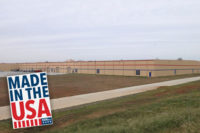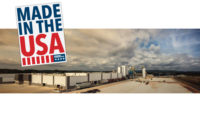Made in the USA: Equipter

Revolutionary tool takes roofing contractor professionalism to a higher level.

Revolutionary tool takes roofing contractor professionalism to a higher level.


The rolling hills of eastern Pennsylvania are often thought of as a quiet, simple place. A scenic area where horse-drawn buggies keep traffic moving slowly along mostly two-lane country roads outlined by grazing livestock and grain silos that dot the daytime sky.
But nestled in between the spacious farmland, rural strip malls and quaint churches that make up Amish Country, sits an industrial park that is now home to perhaps the most innovative and potentially revolutionary product to reach the roofing industry in decades.
The outskirts of Leola, Pa. population barely 7,200, is the home of Equipter — a company with ingenuity and roofing expertise at it roots, and a pro-contractor business culture that’s laying the groundwork for an ambitious future. The company’s signature product, the RB4000, arrived in the roofing market in 2005, and made believers out of roofers that were tired and frustrated with lengthy clean-ups and job-delaying callbacks for damaged property.
The self-propelled trailer elevates, rolls back and dumps a payload of four cubic yards and up to 4,000 pounds of debris. Thousands of roofing contractors in markets across the country are using it on a daily basis to give their customers what they all say they want: a new roof with no mess.
In addition to the administrative offices, the company’s new headquarters includes the entire production line for the RB4000 and other products, like the RB2500, launched at the 2020 International Roofing Expo in Dallas. This downsized version offers all the power and capability of the original RB4000, but adds an additional layer of versatility because of its size. The RB2500 can be driven on sidewalks and into alleyways with its width of less than 4.5 feet, helping contractors stay off freshly manicured lawns and away from inconvenient spaces.
The product was the direct result of customer feedback, which founder Aaron Beiler takes to heart as a former roofing contractor.
“At Equipter, we put our customers first,” he explained. “When we heard our customers say occasionally they need access to particularly tight areas, we set to work designing a new product that could better meet that need.”
That philosophy has always been at the heart of Beiler’s entrepreneurial spirit.
The Buggy is Born
For 15 years, Beiler and his relatively small company roofed homes and other residential properties around greater Lancaster, Pa., and he built a reputation as a trustworthy roofing contractor with a particular knack for detail and high-quality work. He knew the majority of roofers didn’t operate that way, or at least weren’t perceived that way by homeowners sitting across the kitchen table. But he had a better differentiator in mind.
For years, Beiler lamented how much time, energy and ultimately dollars were wasted on what many contractors perceive to be the worst part of the job: the cleanup.
“We never threw our trash on the ground, and instead carried it across the roof to get to a dumpster that’s in the driveway, but that’s very time consuming,” he said.
Worse yet, tossing all the old shingles and roof debris from one or sometimes two stories high created a secondary mess and occasional damage to the lawn, shrubbery or flower beds below. Loading the dumpster any other way also presented its own challenges on site. Beiler went to work, trying to conceptualize a machine that helped contractors with all of those problems.
The initial idea was to build a receptacle that would lift the trash and enable Beiler to fill the dump truck onsite with roofing debris and waste. The more he thought about it, the additional benefit of adding height could also bring a revolutionary change to how residential tear-offs have been done for the better part of a century. Instead of hurling trash downward, they could bring the trash container closer and sometimes right up to the roof line.
He said he started to use it regularly shortly after
building a prototype over the course of a few months. The response was immediate, and it often left homeowners and members of his own crews in awe. Beiler called it the Roofer’s Buggy, and once he realized the contraption’s attention-grabbing qualities, incorporated it into his marketing collateral, particularly billboards.
“We had a feeling we weren’t going to keep it Roofer’s Buggy, but it was a good place to start because we weren’t into manufacturing or marketing,” Beiler explained. “No one knew who we were, so we wanted to keep it simple and recognizable to people in the industry. It’s for roofing, a roofer’s buggy. The name helped. Everyone knew what it was made for.”
At first, people scoffed at the idea of lifting trash receptacles off the ground, but those that really knew roofing could see the potential. Making it mobile and adding other contractor-friendly features made it more marketable.
“I saw him put a lot of time and sweat in, from the engineering to working on it at night putting marketing pieces together,” said Beiler’s son, David, who’s been with Equipter since the beginning and is now vice president of sales. “There was backlash to a new idea in the beginning, but everyone loves the idea, the concept of what it does.”
Though he had some doubts on whether other roofers would receive his invention well, the elder Beiler said he sought a patent immediately. They sold about 50 units within the first year.
Eventually, they changed the name to Equipter because of its versatility and potential use in industries beyond just roofing, which is the company’s next step for growth.
A Continuing Evolution
The key to Equipter’s success is the potential time savings for crews. Beiler said they tell roofing contractors their crews can be up to 30% more efficient with their time. It could mean an extra 80 squares a month, which can translate into steep profits.
While the company typically keeps internal sales and client satisfaction reports close to the vest, Equipter’s leadership shared a recent customer survey that showed more than half of roofers say the RB4000 helps close at least two more jobs a month, and about as many indicated the investment paid for itself in a year or less.
Strong sales and anecdotal evidence aside, Equipter’s leadership team believes it has just scraped the surface of the potential market for its products. In addition to roofing contractors, companies in the equipment rental business are seeing big dividends with the RB4000. In 2019, Equipter’s online database for third-party rental locations grew about 35%. There are now rental locations with the RB4000 in 36 states and three rental spots in Canada.
Part of that interest is fueled by contractors in the restoration and renovation space. Thanks to its versatility beyond debris control, the RB4000’s ability to transport tools and materials helps restoration and general contracting crews simplify operations on the jobsite.
“There’s no doubt in my mind the Equipter has a place in the restoration industry,” said Amos Kauffman, Equipter’s vice president of sales and marketing. “A lot of our marketing and messaging is geared toward the roofing industry so we we’re looking to diversify and expand that.”
Equipter’s internal marketing team is also continuously pushing the envelope with social media campaigns and videos that showcase the product’s utility, while also showing that trash — at least in roofing circles — can be dealt with in a professional manner and still be fun.
The company is even testing the waters with technological advances in roofing. The recently-launched Equipter HUB is a resource center filled with “New Roof, No Mess” marketing assets, sales tips and more to help Equipter customers maximize their investment. New materials in the asset library include updated imagery and brochures, new customer-facing videos for presentations and websites, and a customizable slide deck showing homeowners how roofers will maintain a clean and safe environment throughout the job.
“I think we have really raised the bar in roofing,” Beiler said. “Whether they have the Equipter or not, roofers are much more conscious of their professional reputation than they were 10 or 20 years ago. I think that’s changing a lot and we’ve helped some of that.
“Even the ones without it know that in order to compete today, they need to somehow assure the homeowner that they’re going to protect their flowers and shrubbery,” he continued. “It’s much more that way now than it was 20 years ago.”
That optimism and sense of purpose is infectious, and continues to drive the company and product line forward.
“It’s pretty obvious (Aaron) had a vision and could see something that not a lot of other people could see,” Kauffman said. “He would not be swayed by the naysayers or things that got in the way. He had a vision that he passionately pursued, and still does.”
Looking for a reprint of this article?
From high-res PDFs to custom plaques, order your copy today!








